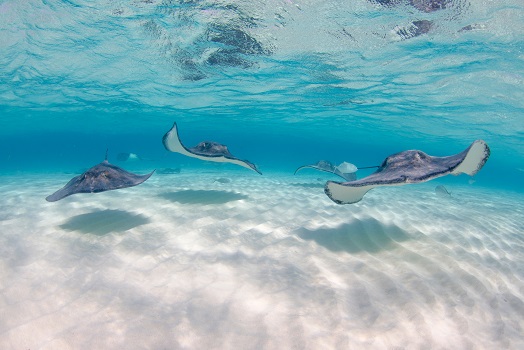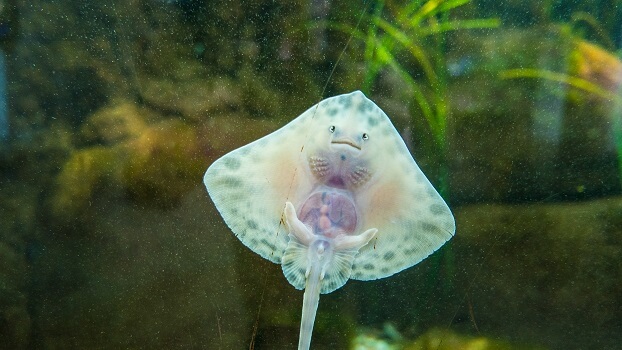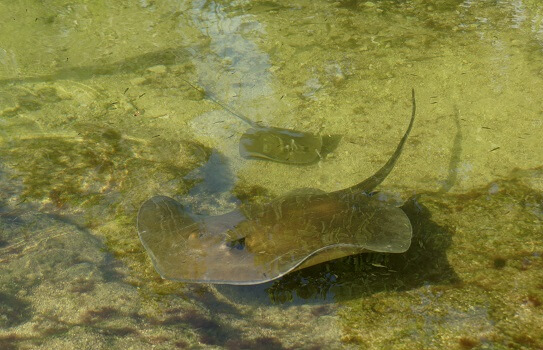
The stingray is a cartilaginous fish that can be found in temperate and tropical marine and freshwater habitats around the world. These fish belong to the order Myliobatiformes and are closely related to sharks. Instead of sharp teeth, like the sharks, some species have a barb at the end of their tail that can be used to pierce potential predators. These barbs are venomous. Stingrays have a flattened body that has pectoral fins and a long tail. Its coloration usually reflects the shading on the ocean floor enabling it to camouflage itself and hide from predators such as sharks. Its eyes are situated on its dorsal (top) side, whereas the stingray’s mouth, gills, and nostrils are found on its underbelly. These cartilaginous fish use their pectoral fins for locomotion. Most stingrays swim by moving their body like a wave, while others flap their paired fins like wings. Their tail can be used to help maneuver them in the water. Like the shark, stingrays have electrical sensors called ampullae of Lorenzini. These organs are found by the stingray’s mouth and sense the natural electrical charges that other animals emit. Many ray species also have jaw teeth which they use to crush mollusks such as mussels, clams, and oysters. During reproduction, the males court the females by following them and biting at her pectoral disc. Stingrays reproduce sexually when the male puts one of his two claspers into her vent. Stingrays are ovoviviparous which means that they give birth to live young. The litters consist of five to 13 offspring. The embryos develop in the female’s womb without a placenta, Instead, the embryos have a yolk sac from which they absorb the nutrients that they need, and after this, the mother provides uterine milk. Once they are born, the young usually disassociate from the mother and swim away and require no maternal care. There are some exceptions to this, such as the giant freshwater stingray (Himantura chaophraya), where the mother looks after her young and they swim with her until they are roughly one-third of her size. Stingrays are considered to be at risk and several species are listed as vulnerable and threatened by the IUCN. The main threats to stingrays are habitat loss, overfishing, and climate change. The main threat is overfishing as rays are not only harvested for their meat but also for their gill plates which are used in traditional Chinese medicine. Stingrays are a diverse group of fishes that can be found in a range of marine and freshwater habitats. Most commonly found in warmer waters, stingrays are cartilaginous fish that are closely related to sharks. Like sharks, they have been around for a really long time and they also lack a swimbladder. Stingrays also have several other biological adaptations that have helped them to persist for millions of years. Let’s take a closer look! While not all stingrays have barbs on their tail, a large proportion of them do and these barbs are venomous! The barb is fairly long and pointed and has several serrations that go in the opposite direction – making it look almost like a Christmas tree in shape. The barbs are used to deter potential predators. The barb contains a venom gland that injects venom into the stingray’s victim. The venom is potent and contains neurotoxins, enzymes, and the neurotransmitter serotonin which slows blood circulation and restricts smooth muscle contraction preventing dilution of the venom. Stingrays are usually gentle, docile animals that will not go out of their way to attack. However, they are the most common cause of fish-related injury in humans. People should be cautious when swimming in an area where stingrays are known to live. While a sting from a stingray is rarely fatal, it can be extremely painful. One way of avoiding this is to shuffle your feet in the sand when walking in shallow waters that are home to these rays. This will warn them that you are there and prevent you from stepping on them and being struck by their barb. If you do get stung then it’s best to treat the wound with hot water and see a doctor immediately. Rays are thought to date back over 150 million years to the Jurassic Period, meaning that stingrays have outlived the dinosaurs! Luckily, their teeth and scales can fossilize which has allowed scientists to discover how long they have been around. It’s rare to find a complete skeleton however as their skeleton is constructed from cartilage which doesn’t fossilize. Stingray fossils are common, especially fossilized teeth, but only a few examples of complete stingray fossils exist. Unlike most fish, stingrays don’t have a swim bladder – an organ that makes fish buoyant – so when they aren’t swimming they start to sink. However, they use the flattened shape of their body and their pectoral fins to glide through the water. The shape of their body and the lack of a swimbladder help them to sink to the ocean floor and hide from predators in the sand. This helps the stingray to conserve energy. Several other fish species also lack a swimbladder including the stingrays close relative, the shark! Like all fish, stingrays breathe underwater but they don’t take water in through their mouths and pump it through their gills as fish do. Instead, stingrays have spiracles which are openings they use for gas exchange. These openings are located behind their eyes and the stingrays use these to take water in. The water can then be pumped through their gills which are located on their underside. The stingray’s mouth is then free to eat as it does not need to take in water. Also, this adaptation allows the stingray to breathe when it is buried in the sand.
Kingdom
Animalia
Phylum
Chordata
Class
Chondrichthyes
Order
Myliobatiformes
Family
8
Genus
29
Species
Approximately 220
Niche
Carnivorous
Length
Up to 6.5 ft (2 meters)
Weight
Up to 790 pounds (358 kilograms)
Lifespan
15 – 25 years
Social Structure
Most are solitary until the breeding season
Status
Threatened
Natural Habitat
Ocean floor
Average Litter Size
5 – 13
Main food item
Mollusks, crustaceans, and small fish
Main threats
Overfishing
The Basics

Stingray Families

Fun Facts about the Stingray!
Venomous Barbs
Stingrays Were Alive During The Jurassic

Buoyancy
Stingrays have Spiracles
